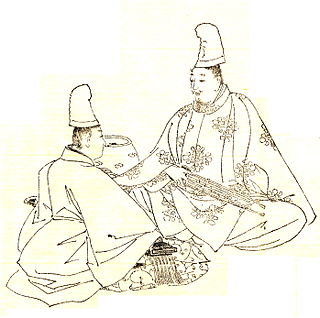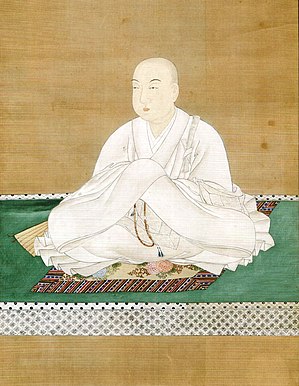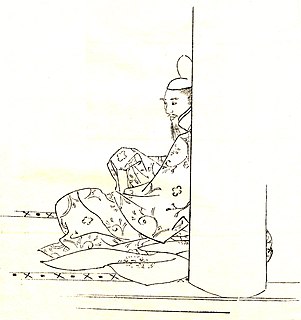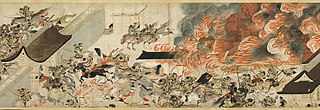The Ōtenmon Conspiracy(応天門の変Ōtenmon no Hen) was a conspiracy that took place in 866 and centered on the destruction of the main gate (Ōtenmon) of the Imperial Palace in Kyoto, Japan. This event is known to scholars today primarily based on the depiction of it in the narrative handscroll ( emaki ) called Ban Dainagon Ekotoba (The Picture-narrative of Great Minister Ban).

The Heian Palace or Daidairi (大内裏) was the original imperial palace of Heian-kyō, the capital of Japan, from 794 to 1227. The palace, which served as the imperial residence and the administrative centre of for most of the Heian period, was located at the north-central location of the city in accordance with the Chinese models used for the design of the capital.

Kyoto, officially Kyoto City, is the capital city of Kyoto Prefecture, located in the Kansai region of Japan. It is best known in Japanese history for being the former Imperial capital of Japan for more than one thousand years, as well as a major part of the Kyoto-Osaka-Kobe metropolitan area.

Japan is an island country in East Asia. Located in the Pacific Ocean, it lies off the eastern coast of the Asian continent and stretches from the Sea of Okhotsk in the north to the East China Sea and the Philippine Sea in the south.
Minamoto no Makoto, a member of the powerful Minamoto clan, was accused by his political rival Tomo no Yoshio of having set the fire. However, Makoto had the support of the Daijō-daijin (Chancellor of the Realm) Fujiwara no Yoshifusa, and was cleared of the charges. Soon afterwards, however, a man claiming to have witnessed the event accused Tomo no Yoshio of setting the fire himself, along with his son. Yoshio was exiled to Izu.

Minamoto no Makoto was the seventh son of the Japanese Emperor Saga, and was the first courtier to be given the name Minamoto. Initially an honorary name given to a number of unrelated courtiers by a number of different Emperors, the Minamoto clan would grow to be an integrated clan family, one of the most powerful and most important in all of Japanese history.

Minamoto (源) was one of the surnames bestowed by the Emperors of Japan upon members of the imperial family who were excluded from the line of succession and demoted into the ranks of the nobility from 1192 to 1333. The practice was most prevalent during the Heian period, although its last occurrence was during the Sengoku period. The Taira were another such offshoot of the imperial dynasty, making both clans distant relatives. The Minamoto clan is also called the Genji (源氏), using the on'yomi reading for Minamoto.
Tomo no Yoshio (伴善男), or Ban Dainagon (伴大納言), was a counsellor of the state in pre-feudal Japan. In Japanese mythology, he was the source for Ban no Yoshio, god of pestilence.
This event, and Fujiwara no Yoshifusa's handling of it, served Yoshifusa well, politically. Many of those executed were his political rivals, and he found himself promoted to Regent ( Sesshō ) soon afterwards.













